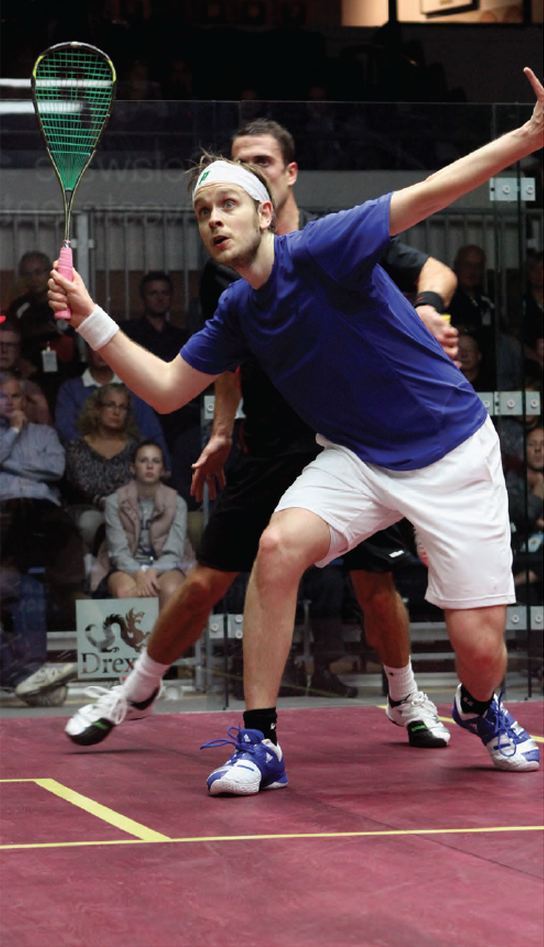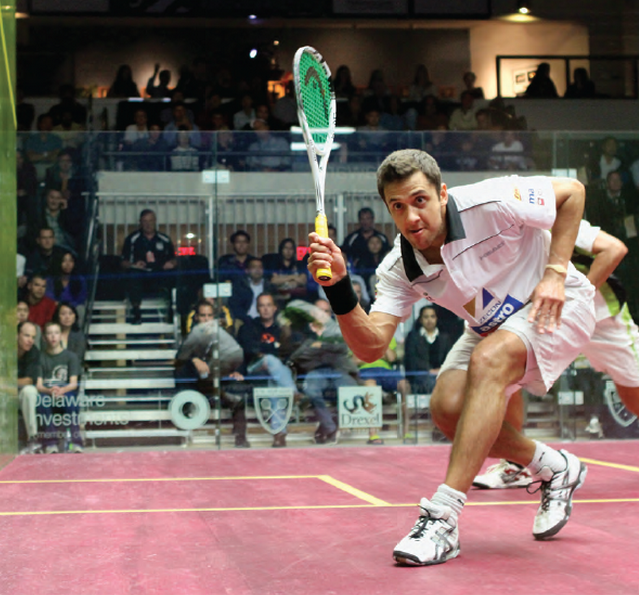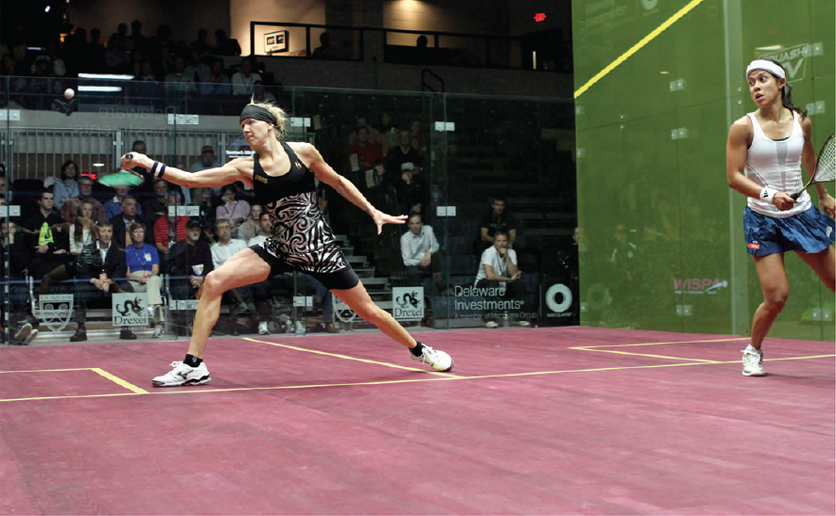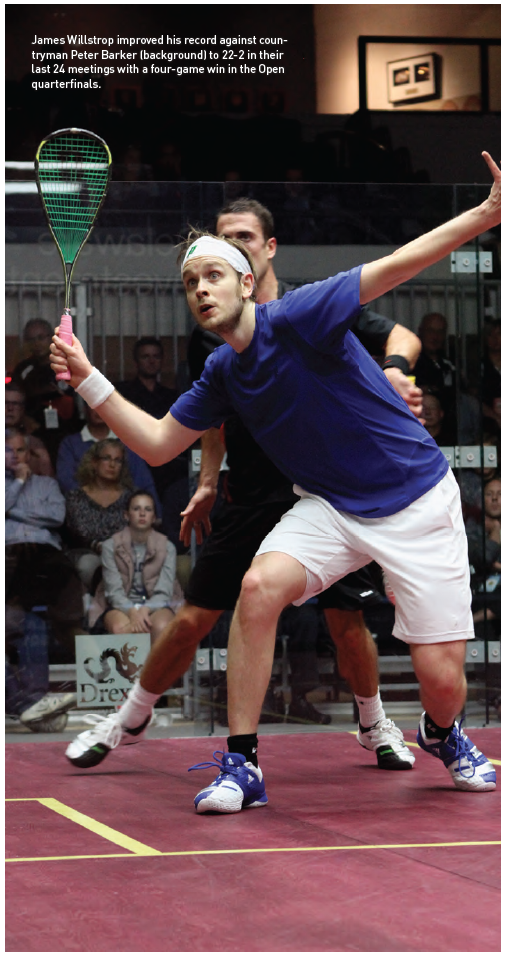
By James Zug
Drexel University’s symbol is the dragon. It is not the only college with a legendary serpentine reptile as a mascot (Minnesota State University Moorhead also fields dragons) but Drexel boasts an enormous, bronze, fire-breathing, claw-swiping dragon statue leaping on the southeast corner of 33rd and Market Streets. Kitty-corner is the Daskalakis Athletic Center, inside of which was the portable McWil Courtwall glass court inside of which Amr Shabana and Laura Massaro finished off an upset-laden tournament with victories in the 2011 Delaware Investments United States Open.
It was hard not to want to breathe a little fire and swipe at the air with joy about a portable squash court tournament coming to Philadelphia, just the second in the city’s history. The first came exactly a quarter century ago and just a few hundred yards from this one, when Penn hosted the hardball $28,500 Mutual Benefit Philly Classic in its 2,900-seat hockey rink. The three-wall glass court was placed near the blue line. “The only ice visible was floating in plastic cups,” reported Squash News in November 1986, noting that there was a “mixed crowd of preppies, squash junkies, Penn students and curiosity seekers.” Mark Talbott beat Clive Caldwell in the finals. (The only two people who attended both tournaments might be U.S. Hall of Famers Sam Howe and Darwin Kingsley.)

With $175,000 in prize money (largest singles purse in U.S. history), 84 players, more than a hundred volunteers, a dedicated, stuffed-with-goodies website and live Internet streaming, the 2011 event was a quantum leap forward.
U.S. SQUASH did a magnificent job turning Drexel’s basketball arena into a cozy, hospitable home for the Open. With pipe and cover dividers, acres of rugs, banners and signs, the squash Wii video game, the food emporiums (a tasty Philly soft pretzel) and three (!) different VIP lounges, it felt almost like squash in your living room.
Except for the honor guard marching with flags and a live rendition of the national anthem before the finals.
Except for the radar gun set up in a corner in between two Lifetime Fitness mini-squash moonbounce courts. Through the week, a kid or two was always having a go at it the gun. Or adults. John White, the new Drexel coach, was long rumored to be the record-holder for ball speed on the court, hitting 172mph on the gun at Canary Wharf in London half a dozen years ago. White couldn’t get above 170 on the U.S. Open’s radar gun, while the new Nolan Ryan of squash, Cameron Pilley, topped out at 175mph.
And most of all, there were the video screens. They were everywhere: at the side of the court, a mammoth one looming over the exhibition space and the four-sided JumboTron directly over the glass court. From various seats, you could watch the action on three different screens, each the size of a small house. With PSA SquashTV supplying the images with a half dozen different cameras (the semis and finals were screened live on the Internet’s ESPN3), it was a debate about whether to watch it live or on the screen.

There was no choice when the replays came up, especially when players challenged calls. It was just the fourth PSA tournament to employ video review (Canary Wharf in London, Australian Open in Canberra and the British Grand Prix in Manchester). The men were allowed one challenge per game on lets and strokes; they lost their right to challenge if they were unsuccessful, but retained their right if they were successful— and at 10-all they had their right to appeal renewed if they had lost it earlier. Video review decreased player acrimony, increased the fun for the crowd (with snappy music underthrobbing the replay) and most of all helped make for more accurate decisions.
A giant billboard at 30th and Market Streets trumpeted the U.S. Open with the faces of its number one seeds, but neither Nick Matthew or Nicol David ended up winning their tournaments. Indeed, none of the top three seeds won in either draw, a very rare occurrence for a major fixture.
For the men, the Americans performed badly: not one of the six in the first round of the qualies won a game, although Todd Harrity pushed Julien Balbo to 16-14 in his second game at Merion. Moreover, Chris Gordon failed to capitalize on his wild card into the main draw and lost in three to Thierry Lincou in the first round; Lincou, the Reunion Methesulah, went on to reach the semis, while Gordon went on to supply commentary for the SquashTV broadcasts.
Mohamed El Shorbagy provided some fireworks. The former world junior champion survived a five-gamer against Stewart Boswell and also reached the quarters. I watched his match with Nick Matthew along with a current top ten and a former top ten player, and both marveled at Shorbagy’s skills but felt the 20-year-old (currently ranked eight in the world) didn’t have the whole package sewn up yet to reach the very top—Matthew was able to break him down towards the latter stages of their match with twisting balls and speed to the front. Indeed, Shorbagy hasn’t beaten a top three player…yet.
Miguel Rodriguez upended Ali Anwar Reda in a long, five-gamer, impressing all with his lightning bolt speed. LJ Anjema won two rounds, including knocking off David Palmer, before going down to Amr Shabana in four hard games.
That seemed to be Shabana’s style. The 32-year-old hopped, skipped and jumped through all five of his matches to win his second U.S. Open crown. Each was four games, and it appeared that he often struggled with the pace in the earlier stages of each match, looking sluggish, defensive and almost disinterested. But then he’d whip a couple of crosscourt volleys into the nick and be back in front. Shabana used that shot at will: notice how many times he hits it off the first service return of his matches.
Unlike some players, Shabana knows how to learn from losing. He talked about his first glass-court match, in the first round of the 1999 World Open in Cairo, when he went on court in front of five thousand people against defending champion Jonathon Power and how that experience taught him a few lessons (he went down 3-0). Going into the finals against Matthew, he had lost five straight times to the Englishman in PSA ranking tournaments, but hadn’t given up learning and was able to blow past a surprisingly weak Matthew defense in his usual four games. It was as if Matthew was wounded or had been blown away by the shock waves of the spin-for-serve— he just wasn’t his usual stout self.
“Shabs too sharp tonight,” Matthew Tweeted after the match. “Was a yard off and he took advantage.”

The peripatetic U.S. Open, in its 39th edition for the men, also marked just the second time it has been in Philadelphia. The first was in 1993 when Tom & Hazel Jones put the tournament on at the Cynwyd Club and added a women’s draw, thus quietly and without fanfare launching the women’s U.S. Open.
Now in its fifteenth running, the women’s Open was more than a sideshow. In fact, at some early round matches, the crowds were larger and more rabid at the two glass-back wall courts where the women were playing. Here the Americans did better. Latasha Khan succumbed in a tough fivegamer, 11-8 in the fifth, (after having a 2-0 lead) to Camille Serme in the opening round. In the qualies Amanda Sobhy upset Jaclyn Hawkes 11-8 in the fifth to make the main draw where she lost to Jenny Duncalf.
A match in the qualies lasted 73 minutes and it was just a four-gamer: Dipika Pallikal survived 11-9, 13-11, 15- 17, 11-8 against Low Wee Wern. Indeed, long matches were the norm. Refuting the notion of a lack of depth in the women’s game, the opening round matches for the women lasted, on average, 45 minutes—just seven less then the men, and that included Omneya Abdel Kawy’s 17-minute giveaway to Annie Au. Kawy’s countrywoman, Raneem El Weleily, ran a different route to a first-round defeat as she lost a 2-0 lead and squandered match balls to lose to Rachael Grinham 14-12 in the fifth. It was a fantastic match. Grinham reeled off the last three points with two backhand cross-court drops and then a forehand cross-court drop.
Grinham, however, then bumped into Laura Massaro, the fifth seed from England. Massaro has been on a tear in the past ten months. She beat three homecourt Egyptians to win the Sharm El Sheikh Open, then dispatched four straight higher-ranked players to win the Cleveland Open, including her first-ever win over World No. 1 Nicol David in the finals (David had a 14-month unbeaten streak at the time). Then she won the British national title over Duncalf in the finals and repeated her win over David in the semis of the Singapore Open this past July.
In the finals, however, Massaro didn’t face David, the number one seed, but rather Kasey Brown. The 26-year-old Aussie has been training with Rod Martin in New York for the past three years and the work has finally paid off. She upset David in the quarters, meaning that David will have to wait another year before she can again attempt to win the one major squash title missing from her glittering career.
Brown had never beaten David in nine previous encounters and moreover had lost badly to the Malaysian superstar recently. In March 2010 Brown went down to David in 23 minutes in Chennai. A couple of weeks later she lost 11-1 in the third in a three-game blowout. Four more losses came in the next year. But in Philadelphia she put it all together and took out David in four. Brown was up 8-0 in the fourth and when David started to make a comeback, Brown almost began to panic, but held on to clinch the biggest win of her career. She then took out Madeline Perry in the semis in four but didn’t have enough gas in the tank to out-distance Massaro in the finals.
The women’s draw had very good diversity: 11 countries represented in the 16 main draw players and a wide range of ages—youngsters like Au, Pallikal and Sobhy, wily veterans like David, Perry and Grinham and mid-career risers like Massaro, Duncalf and Brown. It is helpful that all WISPA players have their names on the backs of their outfits, so the neophyte spectator knows who is who but soon, you get the idea, these powerful, skilled women won’t need the names.





